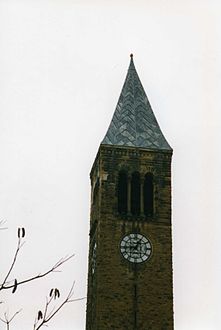- Cornell Chimes
-
 John McGraw Hall, foreground with Jennie McGraw Tower in the background
John McGraw Hall, foreground with Jennie McGraw Tower in the background
The Cornell Chimes are located in Jennie McGraw Tower[note 1] on the central campus of Cornell University, in Ithaca, New York, United States. They have been marking the hours and chiming concerts, since the original set of nine bells first rang at the University's opening ceremonies October 7, 1868. Those nine bells were donated by Jennie McGraw,[1] and have now been expanded to 21.
Contents
The Cornell Chimes
The bells are played by a group of "chimesmasters." Approximately ten chimesmasters play three concerts daily during the school year and a reduced schedule during the summer and semester breaks, making it one of the largest and most frequently played chimes in the world. The chimes are sometimes mistakenly called a "carillon" which is incorrect as a true carillon has at least 23 bells.
Many styles of music are played on the bells, including classical and modern pieces by a range of composers, including Beethoven, The Beatles, Franz Schubert, and Scott Joplin. Commonly played pieces include Edward Elgar's Pomp and Circumstance Marches and the theme from The Muppet Show, as well as a multitude of original compositions. The chimes' music library contains over two-thousand specially arranged pieces and original compositions—both solos and duets.
Every morning concert, since 1869, has begun with the "Cornell Changes" (affectionately known as the "Jennie McGraw Rag"). The chimesmasters' goal is to play its 549 notes as quickly as possible. The Cornell "Alma Mater" is played at the midday concert, and the "Cornell Evening Song" at the end of the evening concert.
Each spring semester potential chimesmasters, "compets", undergo a rigorous ten-week competition to become a chimesmaster. The only requirement to compete is an ability to read music and the energy to climb the 161 steps to operate the playing clavier (there is no mechanical assistance). The first stage of competition requires that compets learn the three traditional Cornell pieces (the "Jenny McGraw Rag," the "Alma Mater," and the "Cornell Evening Song"). Compets play a practice instrument, where the levers strike tuned bars with hammers (like a xylophone), allowing them to learn the instrument without the whole campus listening. To advance to the next round of competition, compets must demonstrate their mastery of the three songs, in addition to sight reading a piece. This audition is played on the main chimes console, but compets only press the dampers halfway, and therefore the chimes remain silent. Those who pass the silent audition move on to coached concerts, and then, finally, judged concerts, where compets take on the full responsibilities of a chimesmaster.
The Cornell Chimes welcome visitors to all concerts.
McGraw Tower
In 1873 the chimes were moved from a ground-level playing stand to McGraw Hall. In 1891, they were moved to their permanent home atop McGraw Tower, designed by Cornell alumnus William Henry Miller. The 173-foot (53 m) tower is Cornell's most prominent landmark and is adjacent to Uris Library. The tower is also home to an office, museum, practice room, and a restored 1875 Seth Thomas clock with a 14-foot pendulum. Visitors can still see the clockworks and pendulum, but the clock was linked to the Global Positioning System in 1999.
The Pumpkin and the Discoball
On October 8, 1997 a pumpkin appeared atop the spire of McGraw Tower. How it was placed there is not publicly known. Because of the danger involved in retrieving it, administrators decided to leave it until it rotted and fell off. However, the pumpkin rapidly dried out in the cold air and remained on the tower until it was removed with a crane on March 13, 1998 (it was planned that Provost Don M. Randel would remove it, but in a practice run the crane basket was blown by a gust of wind and knocked the pumpkin off). Some people had claimed that a real pumpkin could not stay up that long without rotting and that it must be artificial. However, subsequent morphological, chemical, and DNA analysis by both faculty members and undergraduates confirmed that it was indeed a pumpkin.
In April 2005, a disco ball was attached to the top of the tower. A crane was hired to remove the offending orb in an operation which cost the university approximately $20,000.[2]
Gallery
See also
Notes
- ^ It is a common misconception that the tower is named after John McGraw rather than Jennie McGraw, and well-intentioned but misinformed readers of this page have occasionally edited it to say that John, rather than Jennie, lent his surname to the structure. Readers who desire more confirmation of the tower's full name are encouraged to browse, e.g., the many published books which assert that Jennie McGraw Tower is the full name of the tower.
References
- ^ The Quad on the Hill: An Account of the First Buildings at Cornell by Kermit C Parsons Journal of the Society of Architectural Historians Vol 22 Num 4 pp. 214 (Dec 1963)
- ^ Dear Uncle Ezra - Questions for Tuesday, August 9, 2005 - Cornell University
External links
Categories:- Cornell University
- Clock towers in the United States
Wikimedia Foundation. 2010.




